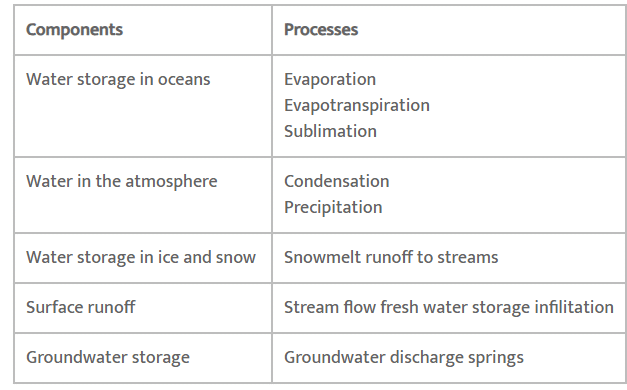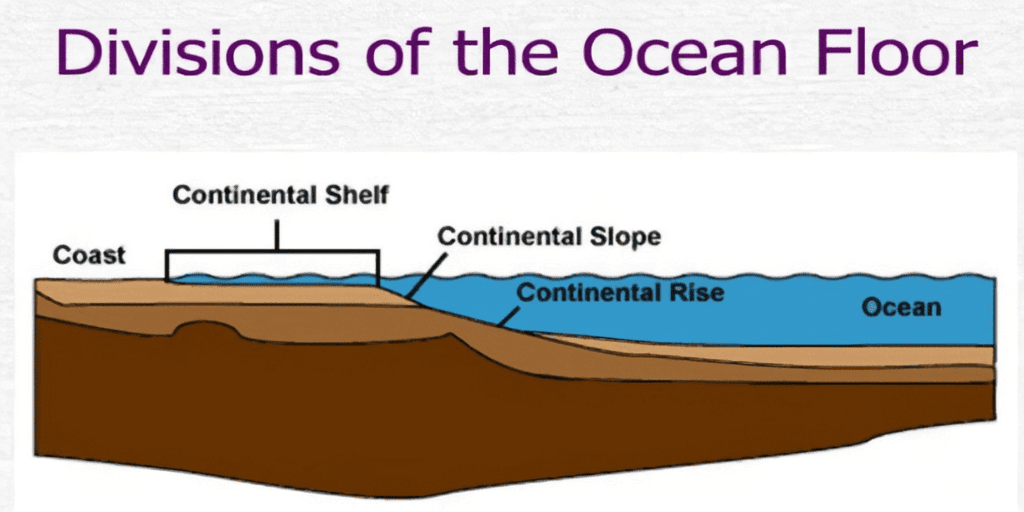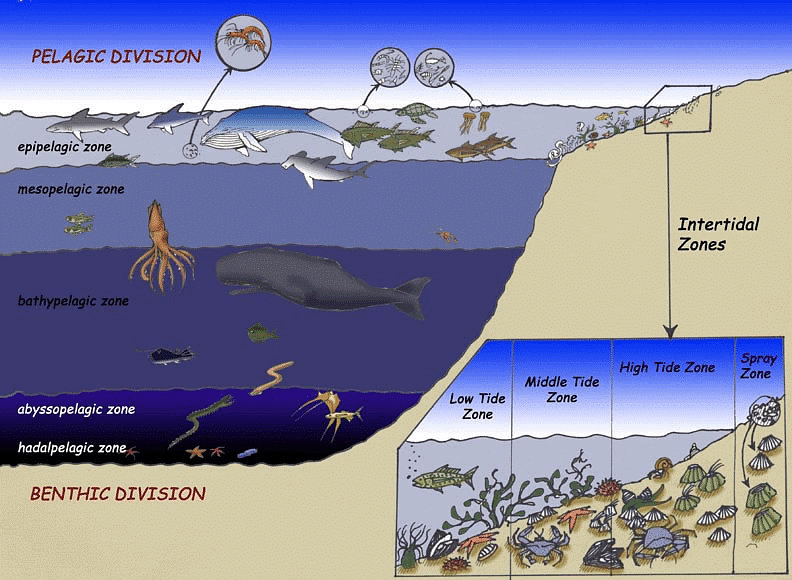UPSC Exam > UPSC Notes > Geography for UPSC CSE > NCERT Summary: Water(Oceans)
NCERT Summary: Water(Oceans) | Geography for UPSC CSE PDF Download
Hydrological Cycle
- Water is a cyclic resource that can be used and re-used.
- The hydrological cycle involves the circulation of water within the earth's hydrosphere in different forms: liquid, solid, and gaseous phases. It includes the continuous exchange of water between the oceans, atmosphere, land surface, subsurface, and organisms.
- About 71% of the planetary water is located in the oceans, while the rest is distributed as freshwater in various forms.
- Approximately 59% of water that falls on land returns to the atmosphere through evaporation, with the remainder running off on the surface, infiltrating the ground, or becoming glaciers.
- The renewable water on Earth remains constant, but the increasing demand is leading to water crises globally, both spatially and temporally.

Components and Processes of the Water Cycle

Divisions of the Ocean Floors
- The oceanic part of the Earth has been categorized into five oceans: the Pacific, the Atlantic, the Indian, and the Arctic.
- Seas, bays, gulfs, and various other inlets are interconnected parts of these vast oceans.
- A significant portion of the ocean floor exists at depths ranging from 3 to 6 kilometers below sea level.
- The submerged 'land' beneath the oceans, known as the ocean floor, showcases intricate and diverse characteristics akin to those found on land.
- Ocean floors are marked by rugged terrains encompassing the world's largest mountain ranges, deepest trenches, and extensive plains. These features are shaped by tectonic, volcanic, and depositional processes similar to those affecting continents.
Major Divisions of Ocean Floors

- Continental Shelf
- The continental shelf represents the extended edge of each continent, characterized by relatively shallow seas and gulfs. It features a gentle gradient, typically around 1 degree or less.
- These shelves generally terminate at a steep incline known as the "shelf break."
- The average width of continental shelves is approximately 80 kilometers.
- Some coastlines, like those of Chile and the west coast of Sumatra, have scant or narrow shelves. In contrast, the Siberian shelf in the Arctic Ocean, the world's largest, spans up to 1,500 kilometers in width.
- Continental Slope
- The continental slope is the steep descent between the continental shelf and the deep ocean floor. It marks the boundary between the continent and the deep ocean basin.
- These slopes are often sites of underwater canyons and channels and exhibit a more pronounced incline compared to the continental shelf.
- Deep Sea Plain
- The deep-sea plain is a vast, relatively flat expanse found beyond the continental slope. This region is characterized by sediment accumulation and minimal surface relief.
- It represents one of the most extensive and uniform terrains on Earth's ocean floors.
- Oceanic Deeps
- The oceanic deeps are the deepest regions of the ocean floor, comprising trenches and abyssal plains. These areas can reach extreme depths, such as the Mariana Trench in the western Pacific.
- They are often associated with intense geological activity and unique ecosystems adapted to extreme pressures and conditions.
Question for NCERT Summary: Water(Oceans)Try yourself: What is the primary source of Earth's water?View Solution
Major Relief Features of the Ocean Floor
- Continental Shelf
- The depth of the shelves varies, ranging from 30m to 600m.
- Massive sedimentary deposits on continental shelves become sources of fossil fuels.
- Continental Slope
- Connects continental shelf and ocean basins.
- Begins where the continental shelf drops off steeply into a slope.
- Gradient varies between 2-5 degrees.
- Depth ranges from 200m to 3,000m.
- Features canyons and trenches.
- Deep Sea Plain
- Gently sloping areas of ocean basins, smoothest regions.
- Depths vary between 3,000m and 6,000m.
- Covered with fine-grained sediments like clay and silt.
- Oceanic Deeps or Trenches
- Deepest parts of the oceans, with relatively steep sides.
- Trenches are 3-5km deeper than surrounding ocean floor.
- Found at bases of continental slopes, island arcs, with active volcanoes, earthquakes.
- Significant for studying plate movements.
- 57 deeps explored - 32 in Pacific, 19 in Atlantic, 6 in Indian Ocean.
Mid-Oceanic Ridges
- A mid-oceanic ridge consists of two chains of mountains separated by a large depression.
- The mountain ranges within these ridges can have peaks as high as 2,500 meters, with some even rising above the ocean's surface.
- For instance, Iceland, which is part of the mid-Atlantic Ridge, serves as an illustrative example.
Submarine Canyons
- Submarine canyons are deep valleys, with some being comparable in scale to the Grand Canyon of the Colorado River.
- These canyons are often found cutting across continental shelves and slopes, and they may extend from the mouths of large rivers.
- The Hudson Canyon stands out as the most renowned submarine canyon globally.
Guyots
- A guyot is a flat-topped seamount.
- These formations exhibit evidence of gradual subsidence through various stages until they become flat-topped submerged mountains.
- It is estimated that over 10,000 seamounts and guyots exist solely in the Pacific Ocean.
Atoll
- Atolls are low islands located in tropical oceans, characterized by coral reefs surrounding a central depression.
- These formations may either be a part of the sea (lagoon) or enclose a body of fresh, brackish, or highly saline water.
Temperature of Ocean Waters
- Latitude: Surface water temperature reduces from the equator towards the poles due to decreasing insolation poleward.
- Unequal distribution of land and water: Oceans in the northern hemisphere receive more heat as they come into contact with a larger landmass compared to those in the southern hemisphere.
- Prevailing wind: Winds moving from land to oceans push warm surface water away from the coast, resulting in the upwelling of cold water from deeper levels.
Longitudinal Variation in Temperature
- Longitudinal variation in temperature is caused by offshore and onshore winds.
- Offshore winds bring cold water towards the coast, lowering the temperature.
- Onshore winds pile up warm water near the coast, raising the temperature.
Ocean Currents and Temperature
- Warm ocean currents elevate temperatures in cold regions.
- Cold ocean currents reduce temperatures in warm regions.
Gulf Stream and Labrador Current
- The Gulf Stream, a warm current, raises temperatures along the eastern coast of North America and the West Coast of Europe.
- The Labrador Current, a cold current, lowers temperatures near the northeast coast of North America.
Horizontal and Vertical Distribution of Temperature
- The temperature-depth profile of ocean water demonstrates a decrease in temperature with depth.
- A boundary region, known as the thermocline, marks a rapid temperature decrease between surface and deeper waters.
- Approximately 90% of water volume lies below the thermocline, with temperatures nearing 0°C.
Temperature Structure at Middle and Low Latitudes
- Oceanic temperature structure in these regions can be described as a three-layer system.
- The top warm layer, about 500m thick, ranges from 20°C to 25°C.
- This warm layer is present year-round in tropical regions and only in summer in mid-latitudes.
Question for NCERT Summary: Water(Oceans)Try yourself: What is the average width of continental shelves?View Solution
Layers of the Ocean
- The ocean can be divided into three main layers based on temperature:

- Surface Layer: The uppermost layer with relatively warmer temperatures.
- Thermocline Layer: Lies below the surface layer, characterized by a rapid decrease in temperature with depth. It is typically 500-1,000 meters thick.
- Deep Ocean Floor: The third layer, very cold, extending to the ocean floor.
Temperature Variations in Oceans
- The temperature of ocean water varies based on location:
- In the Arctic and Antarctic circles, surface water temperatures are close to 0°C, leading to a slight temperature change with depth.
- Surface water near the equator averages about 27°C, decreasing towards the poles at a rate of approximately 0.5°C per latitude.
- Oceans in the northern hemisphere generally have higher temperatures than those in the southern hemisphere, with the highest temperatures slightly north of the equator.
- This variation is influenced by the unequal distribution of land and water in the two hemispheres.
- Heat is transferred to deeper ocean layers through convection processes.
Salinity of Ocean Waters
- Definition of Salinity: Salinity refers to the total amount of dissolved salts in seawater.
- Measurement: Salinity is typically expressed as the amount of salt (in grams) dissolved in 1,000 grams (1 kg) of seawater, often denoted as parts per thousand (ppt).
- Upper Limit for Salinity: A salinity of 24.7% is considered the upper limit for categorizing water as 'brackish'.

Factors Affecting Ocean Salinity
- Salinity in the surface layer of oceans is primarily influenced by:
- Evaporation: Increases salinity by leaving salt behind as water evaporates.
- Precipitation: Dilutes salinity as freshwater is added to the ocean.
Factors Influencing Salinity in Water Bodies
- Surface salinity in coastal regions is influenced by fresh water flow from rivers and in polar regions by freezing and thawing of ice.
- Wind can also affect salinity by transferring water to different areas.
- Ocean currents play a role in salinity variations.
- Salinity, temperature, and water density are interconnected. Changes in temperature or density impact water salinity.
Highest Salinity Levels in Water Bodies
- Lake Van in Turkey: 330 o/oo
- Dead Sea: 238 o/oo
- Great Salt Lake: 220 o/oo
Horizontal Distribution of Salinity
- The salinity in normal open ocean ranges from 33 o/oo to 37 o/oo.
- In the landlocked Red Sea, salinity can be as high as 41 o/oo, while in estuaries and the Arctic, it fluctuates seasonally from 0 to 35 o/oo.
- In hot and dry regions with high evaporation, salinity can reach up to 70 o/oo.
- Salinity variation in the Pacific Ocean is influenced by its shape and size.
- Salinity decreases from 35 o/oo to 31 o/oo in the western parts of the northern hemisphere due to melted water influx from the Arctic.
- Highest salinity is found between 15 o and 20 o latitudes.
- Maximum salinity (37 o/oo) is observed between 20 o N and 30 o N, and 20 o W - 60 o W, gradually decreasing northwards.
- The North Sea, despite its higher latitudinal location, has higher salinity due to more saline water brought by the North Atlantic Drift.
- The Baltic Sea records low salinity because of the large quantity of river water inflow.
Question for NCERT Summary: Water(Oceans)Try yourself: What is the major relief feature that consists of two chains of mountains separated by a large depression on the ocean floor?View Solution
The document NCERT Summary: Water(Oceans) | Geography for UPSC CSE is a part of the UPSC Course Geography for UPSC CSE.
All you need of UPSC at this link: UPSC
|
175 videos|624 docs|192 tests
|
FAQs on NCERT Summary: Water(Oceans) - Geography for UPSC CSE
| 1. What are the components and processes of the hydrological cycle? |  |
Ans. The components of the hydrological cycle include evaporation, condensation, precipitation, and runoff. Evaporation is the process by which water is converted from liquid to vapor, while condensation is the opposite process where vapor is converted back to liquid. Precipitation refers to water falling from the atmosphere in the form of rain, snow, sleet, or hail. Runoff is the movement of water over the land surface into rivers, lakes, and oceans.
| 2. What are the divisions of the ocean floors? |  |
Ans. The ocean floors are divided into four major regions: continental shelf, continental slope, continental rise, and abyssal plain. The continental shelf is the shallowest part of the ocean floor, extending from the shoreline to the continental slope. The continental slope is a steep drop-off that leads to the continental rise, which is a gentle slope at the base of the continental slope. The abyssal plain is a flat, deep-sea region located beyond the continental rise.
| 3. How does the temperature of ocean waters vary? |  |
Ans. The temperature of ocean waters varies depending on the location and depth of the water. Surface waters tend to be warmer near the equator and cooler near the poles due to the distribution of solar energy. In deeper waters, temperature variations are less pronounced and tend to be more consistent. Additionally, ocean currents can also influence the temperature of ocean waters by transporting warm or cold water from one region to another.
| 4. What are the layers of the ocean? |  |
Ans. The ocean is divided into several layers based on depth and temperature. The top layer is the epipelagic zone, which receives the most sunlight and is home to a wide variety of marine life. Below the epipelagic zone is the mesopelagic zone, followed by the bathypelagic zone, abyssopelagic zone, and hadalpelagic zone. Each layer has unique characteristics and supports different types of organisms adapted to the specific conditions.
| 5. How does salinity vary in ocean waters? |  |
Ans. Salinity, or the concentration of salt in ocean waters, varies depending on factors such as evaporation, precipitation, and freshwater input from rivers. Areas with high evaporation rates, such as subtropical regions, tend to have higher salinity levels, while regions with heavy rainfall or freshwater input have lower salinity levels. Salinity also varies with depth, with surface waters typically having lower salinity due to mixing with freshwater sources.
Related Searches
















